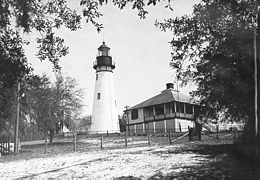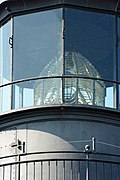 | |
| Location | northern end of Amelia Island marking the St. Marys Entrance Fernandina Beach Florida United States |
|---|---|
| Coordinates | 30°40′23.43″N 81°26′32.94″W / 30.6731750°N 81.4424833°W / 30.6731750; -81.4424833 |
| Tower | |
| Constructed | 1838-1839 |
| Foundation | stone basement |
| Construction | brick with stucco tower |
| Automated | 1970 |
| Height | 64 feet (20 m) |
| Shape | tapered cylindrical tower with balcony and lantern |
| Markings | white tower, black lantern |
| Operator | City of Fernandina Beach |
| Heritage | National Register of Historic Places listed place |
| Light | |
| Focal height | 107 feet (33 m) |
| Lens | 14 lamps with 14-inch (360 mm) reflectors in a revolving lens (1839) 3rd order Fresnel lens (1903) |
| Range | white: 23 nautical miles (43 km; 26 mi) red: 19 nautical miles (35 km; 22 mi) |
| Characteristic | Fl W 10s. red from 344° to 360°, covers shoal water in vicinity of Nassau Sound. |
| Amelia Island Lighthouse | |
| U.S. National Register of Historic Places | |
| Location | 215 1/2 Lighthouse Circle, Fernandina Beach, Florida |
| Area | 2.4 acres (0.97 ha) |
| Architect | Lewis, Winslow |
| MPS | Florida's Historic Lighthouses MPS |
| NRHP reference No. | 03000004 |
| Added to NRHP | February 13, 2003 |
The Amelia Island Light is the oldest existing lighthouse in the state of Florida in the United States. It is located near the northern end of Amelia Island in the northeastern part of the state. Its light marks St. Marys Entrance, the inlet leading to St. Marys River, the Cumberland Sound and the harbor of Fernandina Beach, Florida along the Amelia River. The white light flashes every ten seconds which turns red from 344° to 360° when covering the shoal water in the vicinity of Nassau Sound.
The lighthouse is listed as number 565 in the United States Coast Guard (USCG) light list.
History
The lighthouse was built in 1838 using materials taken from the former lighthouse (the predecessor of Little Cumberland Island Light) on the southern tip of Cumberland Island in Georgia just north of the inlet, which had been built in 1820. The brick tower was originally 50 feet (15 m) tall placed on a hill. In 1881, a lantern was installed on the tower increasing the tower height to 64 feet (20 m) with the focal plane height of 107 feet (33 m) above sea level.
The tower for the light formerly on Cumberland Island was taken down and rebuilt on Amelia Island in 1838. The new light was originally equipped with 14 lamps each with a 14-inch (360 mm) reflector when first lit in 1839. The reflector size was increased to 15 inches (380 mm) by 1848. This arrangement was replaced by a third-order Barbier Benard Fresnel lens in 1903, which is still used in the lighthouse.
The Amelia Island Light was automated in 1970. The next-to-last civilian keeper of the lighthouse was Thomas J. O'Hagan, who was the son of the previous keeper, Thomas P. O'Hagan, and was married to a direct descendant of the first keeper, Amos Latham.
The light remains in operation, but the lighthouse structure is now a private residence.
Management
The ownership of the lighthouse was transferred from the United States Coast Guard to the City of Fernandina Beach in 2001, which now maintains the historical monument. The Coast Guard, though, is still responsible for the function of the beacon. Access to the lighthouse is limited by the city. As of 2015, the lighthouse is not open to the public, except on Saturdays when the grounds are open for viewing for three hours only. The city also offers tours to the lighthouse twice a month.
Head keepers
- Robert Church (1820–1829)
- Amos Latham (1829–1842)
- Capt. Edmund Richardson (1842–1848)
- George W. Walton (1848–1854)
- Horace D. Vaughan (1854–1857)
- James W. Woodland (1857–1859)
- Christopher C. Morse (1859)
- George Latham (1859 – )
- James H. Parker (1864–1868)
- Joseph H. Donnelly (1868–1873)
- Henry Swan (1873–1874)
- Henry Gage (1874–1878)
- Samuel Petty (1878–1879)
- Joseph S. Howell (1879–1880)
- Dewayne W. Suydam (1880–1891)
- Charles W. Grimm (1891–1905)
- Thomas Patrick O’Hagan (1905–1925)
- Thomas John O’Hagan (1925–1954)
- David Martin (1954–1958)
- Otho O. Brown (1958–1962)
- Louis J. Oglesby, Jr. (1962–1966)
- Otho O. Brown (1966–1970)
Gallery
See also
Notes
- ^ Florida Atlas & Gazetteer (4th ed.). Maine: DeLorme. 1997. p. 41.
- Rowlett, Russ. "Lighthouses of the United States: Eastern Florida and the Keys". The Lighthouse Directory. University of North Carolina at Chapel Hill. Retrieved 27 June 2016.
- "Florida Historic Light Station Information & Photography". United States Coast Guard. Retrieved 27 June 2016.
- "National Register Information System". National Register of Historic Places. National Park Service. July 9, 2010.
- "Pub. 110, List of Lights" (PDF). National Geospatial-Intelligence Agency. 2012. pp. 121 (152). Archived from the original (PDF) on 2012-03-15. Retrieved 2012-11-08.
- "Amelia Island Light". Amateur Radio Lighthouse Society. Retrieved 2012-11-08.
- ^ Light List, Volume III, Atlantic Coast, Little River, South Carolina to Econfina River, Florida (PDF). Light List. United States Coast Guard. 2012. p. 5 (39).
- ^ "Historic Light Station Information Florida" (PDF). U. S. Coast Guard Historian's Office. pp. 1–2. Retrieved November 17, 2018.
- ^ "Amelia Island Lighthouse". Lighthouse Friends. Retrieved October 11, 2017.
- "Amelia Island Lighthouse Tour". City of Fernandina Beach, Florida. Retrieved 2012-11-05.
References
- "Historic Light Station Information and Photography: Florida". United States Coast Guard Historian's Office. Archived from the original on 2017-05-01. Retrieved June 29, 2008.
- "Amelia Island Lighthouse". Archived from the original on 2006-02-04. Retrieved January 1, 2006.
- McCarthy, Kevin M (1990). "Amelia Island Lighthouse". Florida Lighthouses. Gainesville, Florida: University of Florida Press.







